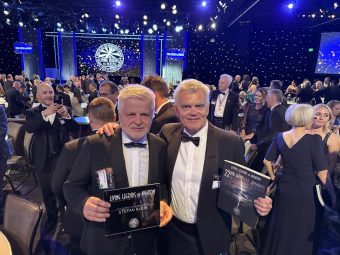Red carpet, spotlights, and celebrities from the world of showbiz — all part of a glamorous evening in Beverly Hills. And then, entering the spotlight: a flying car. No, it’s not a scene from the latest Marvel blockbuster (despite hosts John Travolta and Morgan Freeman), but a real event from the 2025 Living Legends of Aviation gala, where the AirCar — a prototype of the world’s first mass-produced flying car — was officially unveiled.
Behind this marvel stands Klein Vision, a Slovak company led by Stefan Klein — a man of grand vision and even greater patience. Imagine this: 35 years of development, five generations of prototypes, and finally — a vehicle that transforms from a car into an aircraft in under two minutes.
At the event, Klein received a Special Award for Engineering Excellence, and a short documentary about his life’s work was screened to an audience that included Prince Harry, legendary astronaut Buzz Aldrin, and numerous other notable figures. One of the evening’s highlights was a tribute to firefighter pilots for their courageous efforts in battling wildfires in California — a form of heroism that can’t be measured in wingspan or horsepower.

Speaking of power — the AirCar already holds a certificate of airworthiness, has logged over 170 hours of flight, and completed more than 500 takeoffs and landings. Under the hood, it boasts a 280-horsepower engine. So tell me — who would still choose to wrestle with traffic circles when you can simply rise above it all?
Todd Douglas Miller, the award-winning director of Apollo 11, had the chance to watch the AirCar in flight from a second aircraft. His reaction? “They’ve turned dreams and science fiction into something astonishingly real.”
Even James May of Top Gear fame was left speechless — and we all know how rare that is.
To cap off the evening, Klein Vision co-founder Anton Zajac shared some serious figures: the personal air mobility market is growing by over 50 percent annually, and by 2034, it’s projected to be worth $162 billion. And AirCar? It’s already set to claim its share of both the skies and the market.
Even when powered by fossil fuels, flying cars can contribute to sustainability — if used efficiently and smartly integrated into transport systems. Their primary advantage is shorter travel times and the ability to bypass traffic congestion, which can reduce overall fuel consumption and emissions per kilometer traveled. Moreover, modern flying cars are being developed with a focus on aerodynamics and lightweight materials, further boosting energy efficiency.
So, dear readers, if you’ve ever dreamed of skipping traffic on Gazela bridge or soaring over your neighbor’s poorly parked SUV — know this: the world is heading in that direction. The future is no longer “someday.” The future has wings. And its name is AirCar.
Milena Maglovski



